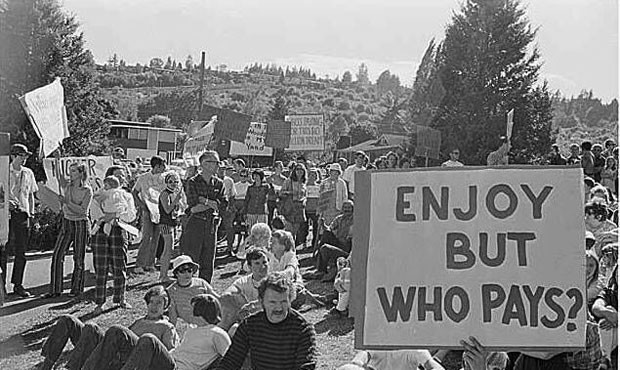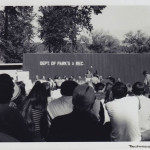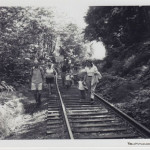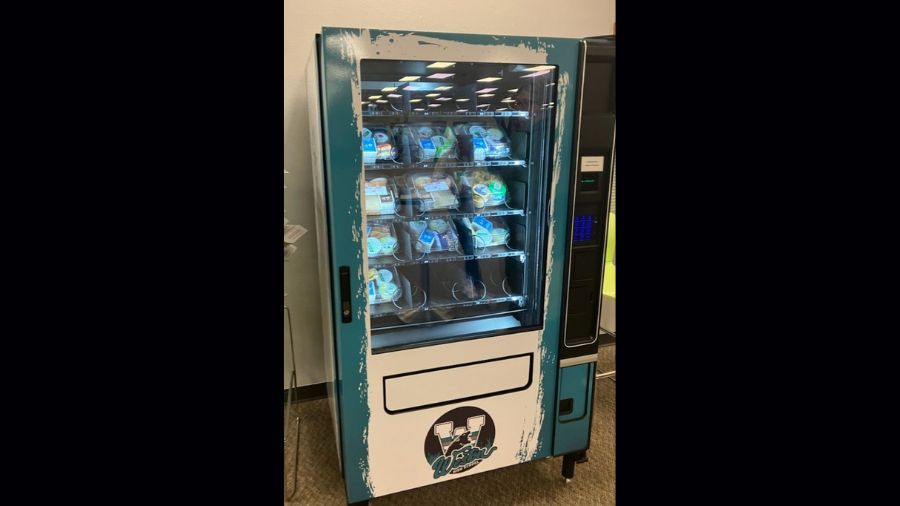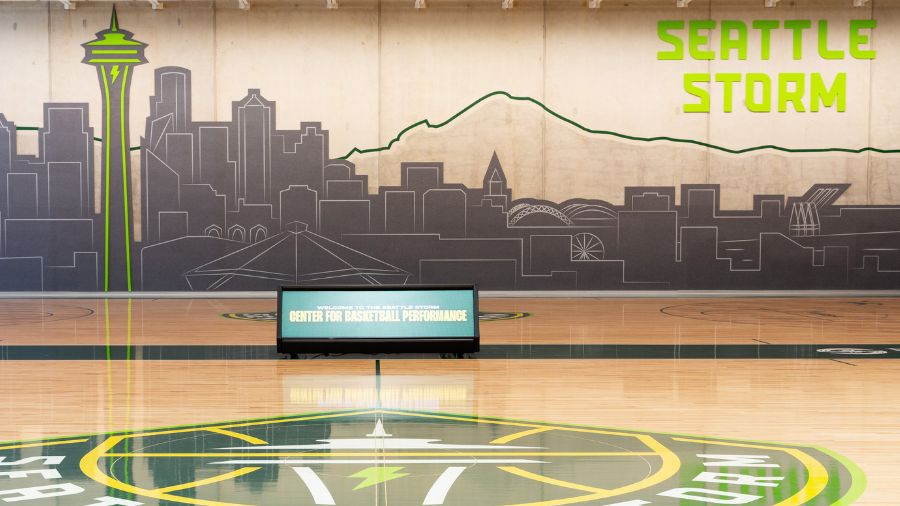People Power created Seattle’s Burke-Gilman Trail
Mar 8, 2017, 6:10 AM | Updated: Aug 3, 2021, 9:11 am
On Sunday, Sept. 12, 1971, hundreds of people began marching toward Matthews Beach Park along the shores of Lake Washington north of Sand Point. Families, couples, adults and senior citizens converged on the park in two streams – one from the south, one from the north. They marched there that sunny late-summer afternoon along old railroad tracks, on a route that dated to the 1880s.
The “hike-in” and rally was organized by Merrill Hille to draw attention and create support for turning the old railroad tracks to a bike and pedestrian trail.
Related: Homeless campers return to Wallingford trail
Elected officials and civic leaders spoke to an estimated crowd of 2,000 people, and the event was a turning point in the history of what became the Burke-Gilman Trail.
With the route for the final “missing link” to the trail announced last month, it’s worth looking back nearly 50 years at how a group of neighbors helped to create a priceless asset for local commuters, recreational hikers and bikers that also served as inspiration for other “rails-to-trails” projects around the country.
Walking on the train tracks
Before the Burke-Gilman Trail was created, Hille lived near Matthews Beach with her husband and children. Like many in their neighborhood, Hille often walked to Matthews Beach with her kids in tow, using the old (but still active) rail line to get there, and crossing the railroad overpass on foot over busy Sand Point Way.
“There was no railing, so we made the kids walk between the rails to get there so they wouldn’t fall over the edge,” Hille said.
In April 1971, Burlington Northern announced their intention to abandon the little-used route and sell off the property at market value. A few months earlier, Hille and her neighbors had anticipated Burlington Northern’s actions and saw an opportunity. In November 1970, they created a grassroots organization to pursue an alternative to the land being sold off in chunks, and to advocate instead for development of a trail along the old rail line.
Though it was old and little-used by 1971, the route had an illustrious history that hearkened back to the earliest decades of Seattle’s rise as a West Coast port.
That rail line was originally built as the Seattle, Lake Shore & Eastern Railway by Thomas Burke and Daniel Gilman, plus a group of investors. They intended to reach from downtown Seattle to Canada, but they built only as far as Arlington before the line was sold to the Northern Pacific Railroad in 1913.
It was a very active route for decades. But by the 1950s, it was mainly used for deliveries to a handful of businesses along the tracks between Lake Union and Kenmore.
Jack Christensen worked for Burlington Northern’s predecessor the Northern Pacific for many years, sometimes running the trains that made those deliveries along the lake. In the 1950s, he often worked on freight trains that ran between Auburn and Sumas, using another set of north-south tracks on the east side of Lake Washington known as the “Belt Line.”
One night, a derailment along the Belt Line blocked the tracks in Bellevue, which meant Christensen’s train from Sumas to Auburn had to be rerouted so it could go down the west side of the lake.
“We had to go down into Seattle on the, what we called the ‘Fifth Sub,’” Christensen said. “That’s now the Burke-Gilman Trail.”
For the leg of the trip south of Arlington, Christensen had swapped duties with the engineer. Christensen was driving the five-locomotive train and pulling dozens of freight cars as they headed west past Kenmore, through Lake Forest Park and past the Naval Air Station that’s now Magnuson Park.
“It was really foggy, and there’s no block signals … the line was only used for local and switching,” Christensen said. “We’re coming down there after midnight, and this engineer was worried about the UW, ‘cause guys would park near the track; not in the clear.”
Christensen says he told the nervous engineer not to worry about errant automobiles parked too close to the train’s path.
“I says, ‘I’m gonna slow down about 10-15 miles an hour,” Christensen said. “If they’re not in the clear, they will be when we go by.”
The train made it through campus, west through Wallingford and Fremont, over a drawbridge (that’s no longer there) and south through downtown Seattle.
“We finally made it down to Auburn, but we were just feeling our way in the dark with a big train,” Christensen said.
Merrill Hille says that by the time she and her family moved to Seattle and bought their home near Matthews Beach, trains ran just a few times a day on the nearby tracks, taking coal to the University of Washington and wood products to Dunn Lumber.
When Burlington Northern announced their intention to abandon the line, King County planners already had their eyes on the tracks for a few years. According to Tom Eksten, who worked as King County’s regional trails coordinator for many years and who now does similar work for Snohomish County, a planning document created as part of Forward Thrust had identified several routes around the metropolitan area as future trails.
Neighbors unite
Plans are all well and good, but it took a significant effort on the part of Hille and her neighbors’ Burke-Gilman Trail Park Committee to make the trail more than just a dotted line on a map buried in a report.
Hille’s neighbors included Irv and Estell Berteig. Irv Berteig worked as a planner for King County. Other members of the committee included Mamie Rockafeller, Frank McChesney and Jim Todd. They made flyers and courted media coverage for the effort, and reached out via mailings for donations of cash and other support. They also connected with supportive community groups, including the Cascade Bicycle Club.
Hille says that in the summer of 1971, the committee leadership arranged a meeting with Seattle Mayor Wes Uhlman. The meeting was scheduled to last just 15 minutes, but instead it stretched to over an hour. Mayor Uhlman liked the idea for the trail, Hille says, but told the group he needed them to generate public support for it.
“I was the only woman who had a part-time job and full-time babysitter so I was free to go no matter what down to City Hall,” Hille said. “So I went down there, and Mayor Uhlman told me to make a hike to advertise the trail.”
The “hike” was the rally on Sept. 12, 1971. Even though some anti-trail protesters also showed up, the event was a catalyst for much of what followed. Letters of support and petitions in favor of the trail began piling up in the mayor’s mailbox at the Municipal Building.
But the path toward making the trail a reality proved to be trickier and more time-consuming than first thought. As the presence of demonstrators at the rally had shown, not everyone along the route wanted pedestrians and bicyclists walking and pedaling through their neighborhoods.
Push-back from the other side
And they often told Mayor Uhlman exactly how they felt.
“I had protesters come down to City Hall, and they said ‘You can’t do this, Mayor,” Uhlman said last week at his office near Green Lake.
Uhlman says some homeowners feared the proposed trail would become a vector for crime, and that their property values would drop.
“The first reason some of them protested was because they lived along this proposed trail,” Uhlman said. “They had beautiful, big, very expensive homes on the waterfront.”
This was also the time of the “Boeing Bust,” when massive layoffs had put the local economy into a tailspin.
“The second reason is that the city was broke. We were laying off fire, police personnel and so some of the protests were saying we need what little money there is, Mr. Mayor, to be for important things instead of trails,” Uhlman said.
But something about the trail project strongly appealed to Mayor Uhlman, and the protests – and an effort by one group to preserve the rails alongside the trail in order to operate a steam excursion railroad from University Village to Kenmore – all eventually fell by the wayside.
“I felt very strongly that this was almost kind of a once-in-a-lifetime opportunity, to have a trail go through the middle of Seattle,” Uhlman said. “And so I held my guns.”
Mayor Uhlman invested a lot of time and political capital into the Burke-Gilman Trail project; voluminous files at the Seattle Municipal Archives marked up with notes and questions show that he took a hands-on approach to building support from local business leaders, state legislators and Washington’s congressional delegation, and to negotiating with Burlington Northern.
Burlington Northern hands over the rails
The efforts of Mayor Uhlman and the Burke-Gilman Trail Committee eventually paid off. In February 1973, Burlington Northern agreed to hand over the railroad line in exchange for industrial property north of downtown. Meanwhile, King County negotiated a separate deal for the portion of the rail line north of the city limits that stretched to Kenmore.
Related: Saving collection led to naming of Douglass-Truth Library
The improved trail — with paving and signage and safety features — was developed in phases by Seattle and King County throughout the 1970s (and, in some places, into the 1990s). The Burke-Gilman Trail now connects with other trails on the Eastside, north to Snohomish County, and across the Cascades. The feared trail-based crime wave never materialized, and proximity to the Burke-Gilman soon became a selling point for homes and apartments along the route.
Wes Uhlman doesn’t think a similar project would be possible nowadays. He says it would just get too bogged down, but also admits that he was often criticized for being impatient with the “Seattle process.”
“I’m not so sure that, as I sit here and think about it at this moment, that that would ever have happened in today’s political climate, because you’d have all the homeless advocates in wanting to build housing; you’d have all the various other special interest groups in wanting to do that instead of making a trail,” Uhlman said.
“I just went ahead and did it,” he said.
Merrill Hille feels differently than Wes Uhlman. She thinks that the kind of civic activism she and her neighbors engaged in is just as possible now as it was back in 1971.
“What I learned from working on getting the trail was that people can do a lot. When I went down to see the Mayor, I always wore the same dress so he would recognize me,” she said, laughing.
Finding a name
She’s also proud of what she and her neighbors accomplished, including coming up with the name for the trail.
Hille, Estell Berteig and Mamie Rockafeller had all read a 1961 book about Thomas Burke called “He Built Seattle” by Robert C. Nesbit. It had been recommended as good background material for their project by a friend, UW archivist and historian Richard C. Berner.
“Burke was the one who pushed for it politically, and Gilman went to New York to get the money for it,” Hille said. “So three of us read this, and we were sitting in the Berteig’s house trying to find a name and the three of us said ‘Burke-Gilman Trail.’”
Nowadays, Hille, who trained as a biologist, is Professor Emeritus at the University of Washington and well-known for decades of work in her field. Even so, the Burke-Gilman Trail, which is listed in the National Rail-Trail Hall of Fame, comes up often in conversations at work.
“I really discovered that a bunch of people can be very powerful if you get together and push for it,” Hille said.
“I tell my students and my colleagues who are new here” about her role in creating the trail, Hille said. “I tell everybody because I’m actually more proud of having done this than all the science I did.”
More from Feliks Banel

